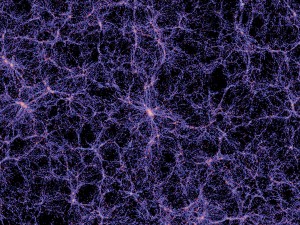
A three-dimensional, simulated visualization of the Universe showing galaxies organized into the cosmic web. Image: V.Springel, Max-Planck Institut für Astrophysik, Garching bei München
The search is an important step forward in mapping the large-scale magnetic field of the Universe because any radio signal from the cosmic web would be generated by the interplay between gas in the filaments and the filaments’ magnetic field.
“Radio emission from the cosmic web has yet to be detected,” says Tessa Vernstrom. “It is expected to be very faint, spread over large areas, and mixed with emission from other sources such as our Galaxy or other galaxies.”
So, instead of directly searching for the signal with a radio telescope, the team compared—or cross-correlated—infrared maps of the sky showing the positions of galaxies, with a radio survey of the sky conducted with the Murchison Wide-field Array (MWA), a radio telescope comprising 2000 antennas in the Western Australian outback.
The distribution of galaxies across the sky should trace the cosmic web in the same way that mapping the distribution of cars in a city would trace the city’s streets. Cross-correlating that map with the radio sky survey would then enhance the web’s radio emission so that it stands out in relief like a mountain range on a map.
Using this method, the team did not directly detect the radio cosmic web, but they did establish a maximum possible brightness for the signal—something astronomers refer to as an upper limit.
“This was the first real search for the radio cosmic web using this approach,” says Prof. Bryan Gaensler. “And now, we’ve verified that the method works and we’re positioned to search properly using the MWA upgrade to be completed later this year.”
Aerial view of the Murchison Wide-field Array in Western Australia. Image: MWA project, Curtin University
The results were published March 22nd in the Monthly Notices of the Royal Astronomical Society. Vernstrom, an astronomer with the Dunlap Institute for Astronomy & Astrophysics, University of Toronto, is the paper’s lead author; Gaensler is a co-author and Director of the Dunlap Institute.
The cosmic web formed when matter in the early Universe coalesced into a network of filaments made up of both “ordinary” matter and dark matter. Ordinary matter—also known as baryonic matter—is the matter we see in stars, nebulae and galaxies. Dark matter is the enigmatic stuff of the cosmos we can’t detect except through its gravitational effect on ordinary matter.
Clusters of galaxies formed where matter in the web is densest. But theories suggest that only 50% of baryonic matter formed into galaxies, and that the balance exists outside the galaxies in clouds of gas in the filaments.
“The radio cosmic web is important to measure,” says Vernstrom, “because detecting it would be an indirect way of finding that missing 50% of the matter.
“Also, the properties of the signal—how bright it is, how bright it is at different points in history, and so on—can tell us about the properties of the filaments’ magnetic field, as well as the history, mechanics and evolution of how the structure of the Universe formed.”
“The amazing all-sky view of the MWA has made this challenging experiment possible,” adds Gaensler. “For the first time, we’ve been able to search for the faint signatures of the magnetic Universe, writ large across the sky.”
-30-
Low-frequency radio constraints on the synchrotron cosmic web
Dr. Tessa Vernstrom
Dunlap Institute for Astronomy & Astrophysics
University of Toronto
p: 416-978-7299
e: vernstrom@dunlap.utoronto.ca
w: dunlap.utoronto.ca
Prof. Bryan Gaensler, Director
Dunlap Institute for Astronomy & Astrophysics
University of Toronto
p: 416-978-6623
e: bgaensler@dunlap.utoronto.ca
w: dunlap.utoronto.ca
Chris Sasaki
Communications Co-ordinator
Dunlap Institute for Astronomy & Astrophysics
University of Toronto
p: 416-978-6613
e: csasaki@dunlap.utoronto.ca
w: dunlap.utoronto.ca
The Dunlap Institute for Astronomy & Astrophysics at the University of Toronto is an endowed research institute with over 40 faculty, postdocs, students and staff, dedicated to innovative technology, ground-breaking research, world-class training, and public engagement. The research themes of its faculty and Dunlap Fellows span the Universe and include: optical, infrared and radio instrumentation; Dark Energy; large-scale structure; the Cosmic Microwave Background; the interstellar medium; galaxy evolution; cosmic magnetism; and time-domain science.
The Dunlap Institute, Department of Astronomy & Astrophysics, Canadian Institute for Theoretical Astrophysics, and Centre for Planetary Sciences comprise the leading centre for astronomical research in Canada, at the leading research university in the country, the University of Toronto.
The Dunlap Institute is committed to making its science, training and public outreach activities productive and enjoyable for everyone, regardless of gender, sexual orientation, disability, physical appearance, body size, race, nationality or religion.
###
